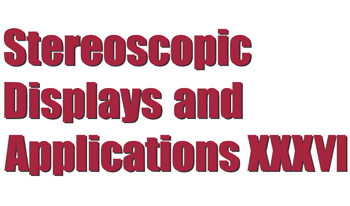
In this document we provide an overview of the 36th annual Stereoscopic Displays and Applications conference. It also serves as the introduction to the 2025 SDA conference proceedings.
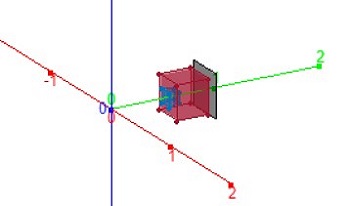
This paper describes a software package called 3D Distortion Model (3DDM), which we developed to provide a better understanding of stereoscopic display design. The software is based on contemporary geometric models of stereoscopic perception from the scientific literature. The user can input stereoscopic display design parameters, and the software will calculate the resultant image metrics and perceptual space distortions. There are several options for visualization of these results. In a live mode option, subsequent changes to design parameters will update calculations and imagery in real time. Additionally, the user can lock specific parameter values and explore how changes in one input variable will necessitate changes in another. Using both numerical output and provided figures, the user can predict how specific parameter changes and subsequent perceptual distortions may impact the usability of the display itself. This software provides the capability for considering scene information, display design and the human user experience.
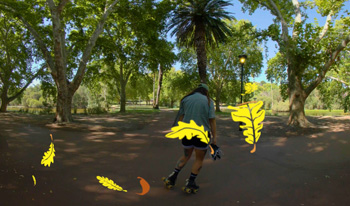
In 2024, the VR180 3D short film “Love Letter to Skating” was produced as part of a Curtin University HIVE Summer Internship project conducted by Curtin University student Cassandra Edwards (Cass for short). The film topically explores Cass’s fascination with skating since her childhood years. The location for the shoot was Hyde Park, a beautiful inner-city park with extensive gardens and large over-hanging trees in Perth, Western Australia. The production was filmed using a Canon R5C camera fitted with a Canon Dual Fisheye lens. This particular paper focuses on the stereoscopic post-production workflow. All stereoscopic content filmed natively with two lens cameras have some level of stereoscopic alignment errors. In the post-production stage, the native dual-fisheye 8K footage from the camera was converted to equirectangular format using the Canon EOS VR Utility software. The equirectangular VR180 3D footage was rectified using Stereoscopic Movie Maker V2 software. The rectified footage was then imported into Adobe Premiere where it was edited and combined with sound, music and graphics for the final production. Computer graphics were composited into the final film at the correct depth within Premiere. The final production premiered at the MINA 2024 – the 13th International Mobile Innovation Screening and Smartphone Film Festival 8th November 2024.
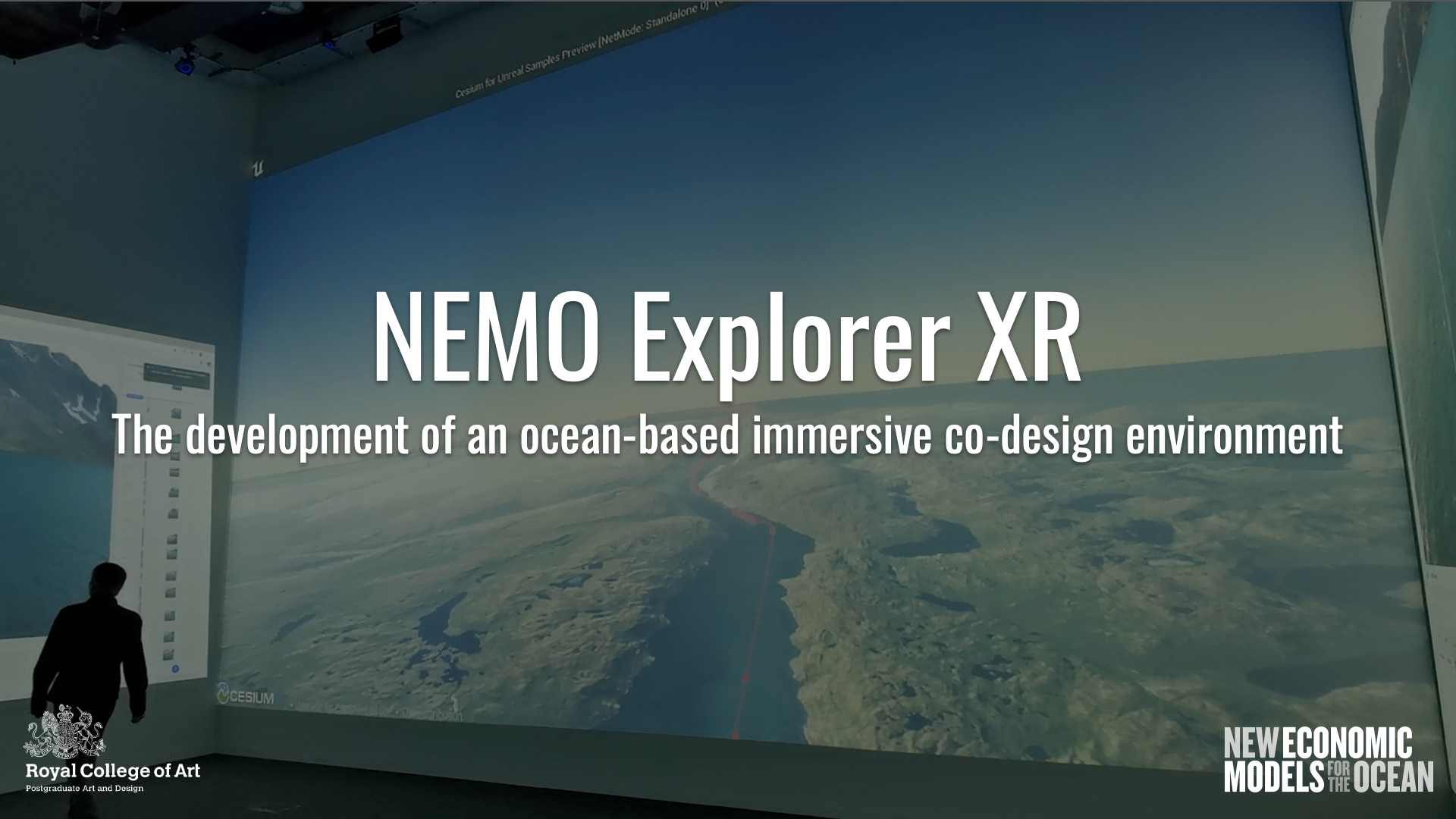
The NEMO project (New Economic Model for the Oceans) tackles ocean-related issues from a design perspective. The initial NEMO project is based on an experimental data gathering using 4K cameras to capture objects along a ship voyage of 6,070 nautical miles from Kangerlussuaq (Greenland) to Poole (UK) via Sardinia (Italy). This data was combined with recorded GPS coordinates to visualize the journey using the Cesium.js environment. Several objects were identified and mapped to the corresponding locations of the ship trajectory. In this work, we are using this initial web visualization as starting point to create a first prototype of an UNREAL engine-based immersive environment which can be explored within the new RCA SNAP Visualization Lab facility. Based on a previous co-design workshop locally ran at the RNLI headquarters in Poole, we started to explore opportunities to enable similar experiences in an immersive 3D environment. The ultimate aim is to enable collaborative data visualization and exploration in the context of co-design workshops. In this way, we are combining Macro-Meso-Micro perspectives with the purpose to provide on one hand a holistic overview of the journey, and on the other hand enable place-based exploration of ocean- and coast-related scenarios.

This research presents a novel post-processing method for convolutional neural networks (CNNs) in character recognition, specifically designed to handle inconsistencies and irregularities in character shapes. Convolutional Neural Networks (CNNs) are powerful tools for recognizing and learning character shapes directly from source images, making them well-suited for recognition of characters that contain inconsistencies in their shapes. However, when applied to multi-object detection for character recognition, CNNs require post-processing to convert the recognized characters into code sequences, which has so far limited their applicability. The developed method solves this problem by directly post-processing the inconsistent characters identified by the convolutional neural model into labels corresponding to the source image. An experiment with real pharmaceutical packaging images demonstrates the functionality of the method, showing that it can handle different numbers of characters and labels effectively. As a scientific contribution to the fields of imaging and deep learning, this research opens new possibilities for future studies, particularly in the development of more accurate and efficient multi-object character recognition with post-processing and their application to new areas.
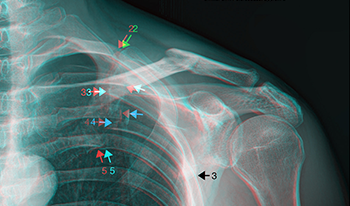
We present several stereoscopic 3D radiographs, obtained in a clinical setting using a technique requiring minimal operator training and no new technology. Reviewing known perceptual advantages in stereoscopic imaging, we argue the benefits for diagnosis and treatment planning primarily in orthopedics, with opportunities likely extended to rheumatology, oncology, and angiology (vascular medicine/surgery). These advantages accrue with the marginal additional cost of capturing just two or three supplementary radiographs using the proposed method. Presently, computed tomography (CT) scanning is standard for obtaining 3D imagery. We discuss relative advantages of stereoscopic 3D radiography (3DSR) in imaging resolution, cost, availability, and radiation dose. Further discussion will describe obstacles and challenges likely to be encountered in clinical implementation of 3DSR, to be mitigated through targeted training of clinicians and technicians. Further research is needed to explore and empirically validate the potential value of 3DSR. We hope to pave the way for this more accessible and cost-effective 3D imaging solution, enhancing diagnostic capabilities and treatment planning, especially in resource-constrained settings. (All 3D radiographs presented in this paper are in the red/cyan color anaglyph format. 3D anaglyph glasses are commonly available online, or in most comics bookstores. This report’s images can be found in L-R stereo-pair format, suitable for 3D viewing with a 3D screen or stereoscope, at this URL: https://www.starosta.com/3DSR/)

Many questions span industry and academia about the value and viability of Virtual Reality (VR). The cost and discomfort of current VR headsets leave many people wondering if Virtual Reality is worth the investment. The empirical study described in this discourse examined levels of immersion, reported realism, and presence reported by users of different consumer available immersive technologies, tradeoffs to attaining immersion, and users’ intention to adopt VR after experiencing the technologies. The researchers used Elite Dangerous, a space flight simulator game optimized for both VR and flat screen condition of the research. The study reported here explored the research question: do users reported a difference in levels of immersion, realism, and presence impacted by a VR device versus a flat monitor display? This between groups experiment presented users with the Oculus Rift VR headset condition and a flat screen experience in which a simulated 360° view was afforded by the tracking the user’s head movement and controlled virtual camera angels displayed on a flat screen monitor. Participants noted intrusiveness, discomfort, controls being difficult to learn, and difficulty seeing in the VR condition. This diminished user satisfaction could be a barrier to anticipated benefits of VR, which highlights exigency for VR User Centered Design (UCD). Participants who experienced the flat screen experience first and VR headset second were significantly more likely to report an intent to adopt VR than those who only experienced the VR condition. This could lead to research on the impact of juxtaposition of new technology with existing technologies on user perception and the intent to adopt.

Sublimity has long been a theme in aesthetics, as one of the human emotions experienced when perceiving vastness, terror, or ambiguity. This study investigated the visual conditions that evoke sublimity using virtual reality (VR). Participants observed sublime content, developed based on previous research, under two factors conditions of (1) wide or narrow fields of view (FOV), and (2) 2D or 3D video presentations. We collected psycho-physiological evaluations from the participants. The results demonstrated that a wider FOV enhanced the perception of sublimity and pleasantness. In particular, gaze fixation time tended to increase under conditions of wider FOV and 3D presentation, supporting the effect of sublimity in VR. This suggests the potential of VR as a valuable tool for amplifying the experience of sublimity.